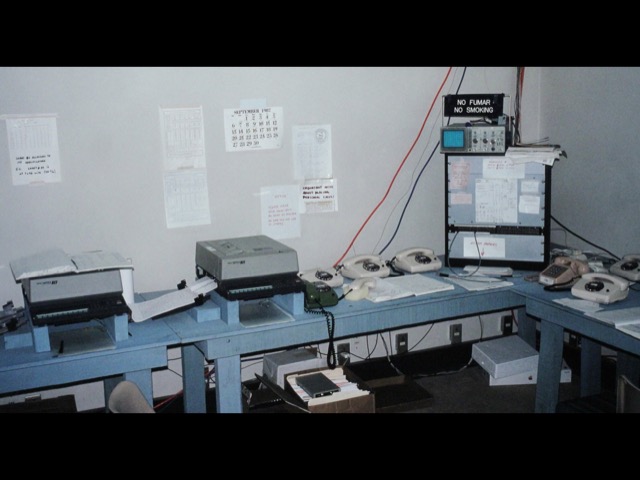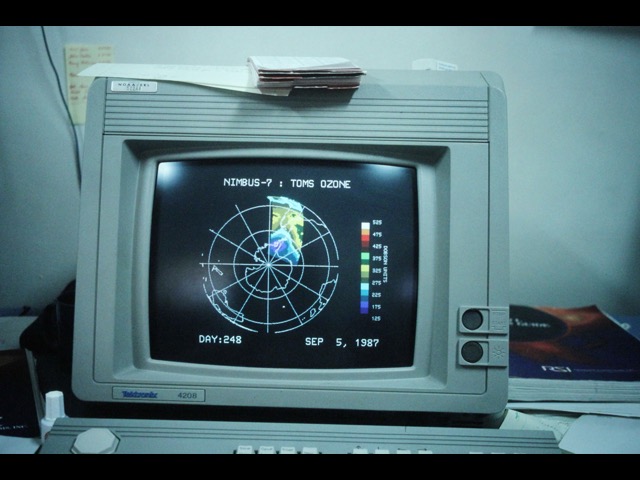The Airborne Antarctic Ozone Experiment 30 years on
By Adrian Tuck
17th August 2017
It is 30 years today since the NASA ER-2 706 made its first flight south from Punta Arenas on the Straits of Magellan, in order to investigate the causes of the ozone hole by deploying a payload of in situ instruments designed to test theories about the precipitous loss of ozone inside the Antarctic lower stratospheric vortex in late winter and early spring. The instruments included ClO & BrO, O3, H2O, NOy, N2O, whole air, temperature profiling, aerosol sizing, counting and collection and meteorological observations of wind, temperature and pressure. When the pilot was briefed on the meteorology he could expect, scepticism was expressed about westerly winds of 125 knots and temperatures of -90°SC. However, not only did he lose his bet, but he encountered low visibility in the form of polar stratospheric clouds almost upon reaching altitude, 70 mbar, over the Drake Passage. He had to turn back at 67°S because the temperature had reached -90°SC, the temperature at which the fuel would start to freeze. This was 5° latitude short of the limit set under the operational safety rules. These observations set the stage for the following 11 flights that took place up to the 22nd September, and for the first mission of the newly acquired NASA DC-8 717, which flew 13 flights with upward looking and limb scanning spectrometers observing column densities of several chemical species and a lidar remote sounding instrument measuring overhead aerosols and ozone profiles, along with in situ instruments for water, ozone and whole air, between 28th August and 29th September. As the flights progressed, it became clear that chlorine atoms and chlorine monoxide, liberated by reactions on the surface of polar stratospheric clouds, were destroying the ozone at a few percent per day, in vortex air that had lost much of its reactive nitrogen and water vapor, by sedimentation under gravity from polar stratospheric clouds. The observational results were interpreted with the aid of meteorological analyses from both US and overseas meteorological agencies, who also supplied forecasts for both the Punta Arenas airfield and the flight paths over Antarctica. The TOMS instrument on the Nimbus 7 satellite provided vital observations of the distribution of ozone column over the Antarctic region, for both flight planning and scientific analysis, along with SAGE 2 on PSC distributions.
The results had an immediate impact upon the Montreal Protocol meeting which was being held in September, and later in testimony to Congressional committees in the House of Representatives and the Senate. The legacy was embodied in international legislation that banned the CFCs and halons responsible, and further missions to the Arctic and Antarctic throughout the period to 2000 which revealed a wealth of detailed extension and confirmation of the scientific conclusions.
The AAOE was put together at short notice following the STEP-Tropical mission from Darwin in January-February 1987, when it was noticed that with the addition of instruments for chlorine monoxide and a suitable stratospheric tracer (N2O) the ER-2 was well equipped to address the critical questions about the ozone hole. The participants shared an air of pioneering excitement during the mission, which involved over 200 people, and were well aware that the eyes of the world were upon them. The memories and the importance of the scientific and legislative outcomes are their legacy.
It is interesting to note that the first flight of a water vapor instrument into the stratosphere was on 17th August 1943, 44 years before to the day, at the height of World War II, when an RAF Flying Fortress flew a frost point hygrometer into the lower stratosphere over southern England, to investigate the contrails which were causing problems for the strategic bomber offensive. It revealed the extreme dryness of the stratosphere, and led post war to the seminal formulation of the Brewer-Dobson circulation. Military aircraft are designed for the kind of performance that makes them suitable for scientific research, and it continues today, 74 years later with such platforms as the WB57F and the Global Hawk UAS.


As project scientist for AAOE, I had the responsibility of organizing the mission structure and support, a task that included building laboratory space in the ER-2 hangar and arranging for the meteorological data from the UK Meteorological Office and the European Centre for Medium-range Weather Forecasts to be received for both the wind sensitive ER-2 takeoffs and landings, and for flight planning the stratospheric conditions over Antarctica that would be encountered by the ER-2 and the DC-8. The meteorological data were received by 7 fax machines, which were worn out at the end of the 6 weeks that occupied the flights (no internet in 1987!). To assure the pilots – and ourselves – that the ozone hole was in place and within reach, we received TOMS data over lines from a satellite receiving station at Puerto Montt, some 12° latitude to the north, along with data from SAGE 2 on PSCs. A couple of aviation meteorological footnotes: there were three runways at Punta Arenas, the main one at 270, and two crosswind runways – at 290 and 310! On one occasion the surface winds were so strong that the daily radiosonde launch was lost over the tracking radar horizon at 700 mbar; the ER-2 landed on 9th September in 41 knots 10-minute average at Punta Arenas gusting 60% higher, 16 knots above the 10-minute total wind limit and 26 above the cross wind limit, accompanied by the comment from the head of aircraft operations at NASA Ames "that's how these boy fighter pilots earn their pay."
The mission funding totalled about $15 million, coming from NASA, NOAA, NSF, Universities, UKMO, ECMWF and the Chemical Manufacturers Association. There were science team meetings at Estes Park CO, Hampton VA, and Cambridge MA through 1987-88, and a public one at Snowmass CO in May 1988 with global media coverage. That was after evidence to Congress, and before the two special issues of Journal of Geophysical Research - Atmospheres 94, D9 & D14, in August and November 1989.